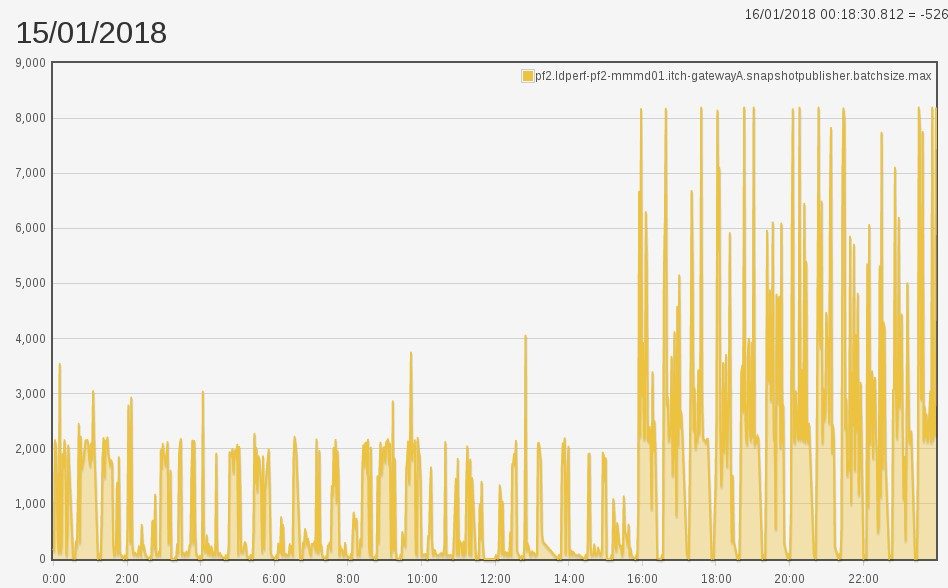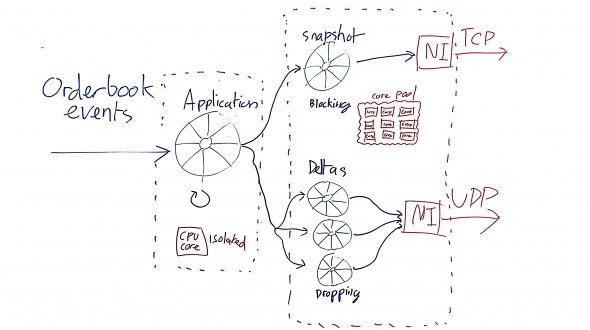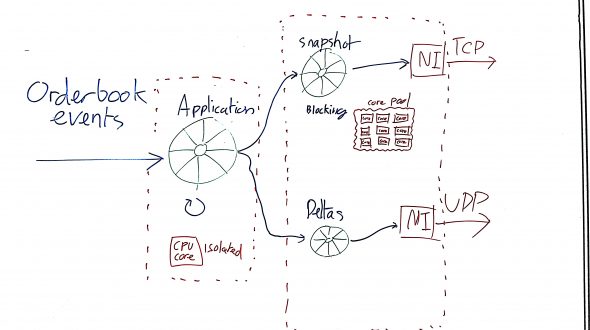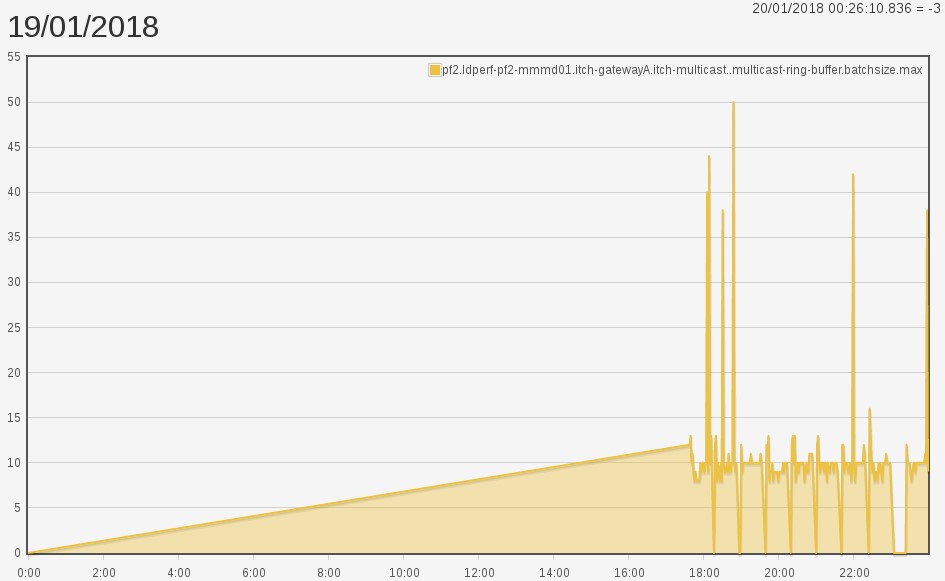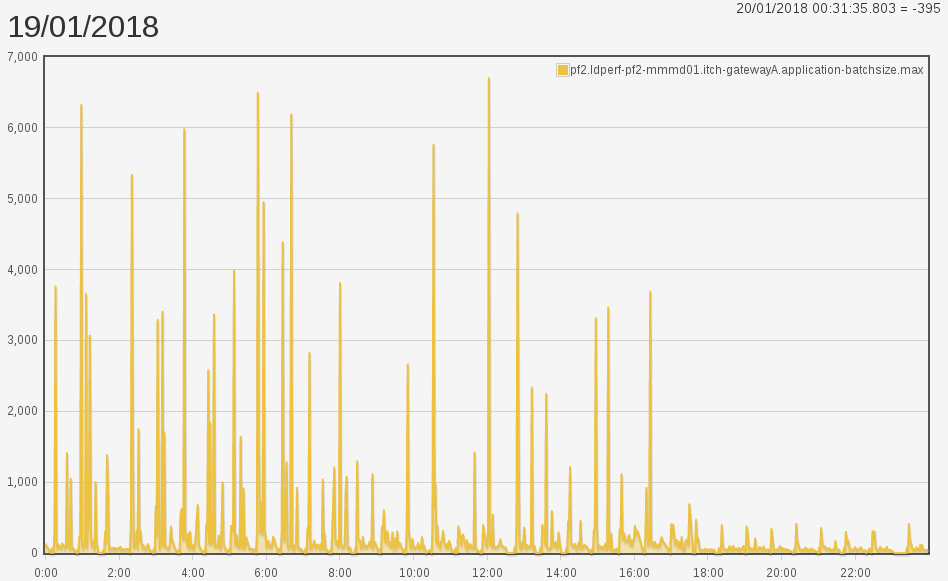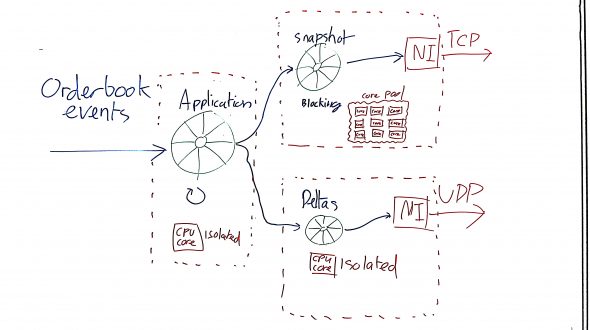We have a problem. A good ol’ fashioned ringbuffer getting full and dropping messages problem. Brilliant, this is definitely what one wants to happen in their Itch market data feed in a production environment.
You know, the delta stream where we broadcast every price change and trade to clients? The one where they expect low latency and to receive every event. Yep, definitely a problem.
So why can a ring buffer get full? Well, it means writes are occurring more frequently than reads whatever is consuming messages is unable to keep pace with what is publishing them. The consumer will see delayed data during conditions like this not what we want in an application intended to have low latency characteristics.
One symptom of ringbuffer filling we often check is the maximum batch size of our consumer; we expect it to be spiky. That’s because it measures the largest amount of events available to process since the last time it checked. It’s a good metric to correlate with problems. (see James Byatt’s “Monitoring Without Polling” article for more information).
Ultimately, bigger, more frequent spikes equates to bad.
Lets have a look at one of the stream’s maximum batch size…
So we definitely have a problem! We are running 14 of these delta streams concurrently, and all seem to have the same issue.
Slipped through the testing cracks
“Why didn’t we catch this earlier?”
We have a performance environment featuring this component why don’t we see this issue there?
Well, when we look at the performance environment’s metrics, it shows low latency and low batch size. We notice, however, that the load configuration is set to have fewer delta streams, each with fewer order books than the production configuration. Meaning that there were fewer price changes coming. So each stream delivers an order of magnitude less of messages. We changed the configuration to be like production, and, hey presto, the metrics showed our familiar spiky batch sizes.
Problem reproduced (hurray).
A deeper look
Now that we have established a feedback loop for ourselves, we can start an investigation. We now know the symptoms of the issue are relevant to the amount of delta streams or the amount of price changes.  Let’s investigate by having a look at the Itch gateway threading model.
The Itch gateway has two responsibilities:
1) Provide a delta update of every order book event and broadcast it via UDP multicast;
2) Provide a snapshot of the current order book. This is so clients can get a full view of the order book and then apply the deltas to it. This request is via TCP.
When an event arrives into the application thread, this will hand the event to the following threads:
1) The snapshot thread – this will maintain a copy of the order book, and respond to snapshot requests;
2) Each delta thread – if it cares about the event. It will then marshal the event and send out the delta to the network interface for some IO goodness.
It gets a bit weird
The ringbuffers that back the delta streams use a dropping overflow strategy; events will be dropped by the writer when the buffer is full – this is the symptom of our main problem. The alternative would be to block (to wait for a free slot), but we want to avoid blocking the application thread; particularly as the ITCH protocol itself allows downstream clients to recover from this sort of drop.
When we increase the amount of delta streams we had in our performance environment, this happened to our application ring buffer’s batch size max:
Considering what we know about the model, this is unexpected. The application thread is only doing a bit more work now, which is to put more messages in the delta ringbuffers. Underneath it is only assigning something to an array, a very cheap operation. How could increasing the amount of delta traffic have such a profound effect on the application thread’s batch max?
Well, the snapshot buffer thread uses a blocking overflow strategy; it can’t afford to miss messages, because it has to maintain a coherent picture of the orderbook. What does its batching behaviour look like after our change?
Different again! Now, that thread shouldn’t be doing any more work in this configuration on the left or right side of the buffer. Yet it has also regressed.
The buffer size is 8192. Those spikes are filling the ringbuffer, pushing back onto the application thread.
How has this happened?
We know that the snapshot and delta threads have no shared state in our application. We must therefore start to look outside our application for other things they might contend on. We need to look at what external resources the snapshot thread and the delta threads share.
- The snapshot and delta threads use different network interfaces.
- The snapshot and delta threads even use different network stacks:
– The snapshot thread runs on the standard Linux kernel stack.
– The delta threads all run on the Solarflare OpenOnload stack (but this does mean they all share the same stack).
- The CPU cores the threads run on.
Let’s look at the CPU affinity configuration.
Tons of threads!
The application thread is bound to a single isolated core. This means the core only has one job, which is to process the application thread only. Not even the operating system can interrupt and give the core tasks to do (isolcpus for the win).
The snapshot and delta threads have a pool of 18 non-isolated cores available to them. Meaning each thread can hop between cores; they will be battling each other for some of that sweet, sweet CPU attention. That overhead isn’t free. It would have to reload its CPU cache every switch, rely on the OS scheduler to find an available core and assign. All this can add up.
These threads use yielding strategies too, leading to expensive core usage even when no data is being written to the buffers they read from.
Not tons of threads?
What if this is the problem? Is our shared pool for the delta threads design harmful? Let’s run an experiment. We’ll do the work of all the current delta threads onto a single thread. Our model now looks like this:
It’s still using the core pool, but we’re down to only two threads having to wage war with many sibling threads for CPU attention. How do our batch sizes look now?
Completely different! Before we were seeing an individual delta spiking into the thousands. In our new world, we have a single thread handling all deltas teetering spikes at around 50.
What does our snapshot and application threads look like?
Snapshot thread:
Application thread:
The snapshot spikes have gone from full capacity (8192) to around 600. While mid run application spikes have vanished.
Isolation
This is a great improvement, but we can do more. What if we bind the delta thread onto its own isolated core like we do for the application thread?
Now what do our batch sizes look like?
Fantastic! The spikes are no more. Problem resolved.
Things learned
Lesson 1
Get the performance environment exactly in line with production. If the state is not representative, performance regressions can sneak through the gaps.
Lesson 2
More threads != more power
Obvious in hindsight. Even when there are more cores than threads, the more participants in the CPU race, the more tripping over will occur. It’s important to remember that half of the available CPUs are hyperthreads, too.
Lesson 3
It’s worth trying a simple solution first, even if you’re not sure it will be performant enough. Then listen to your performance measurements. Only if the feedback says it’s not good enough should you push for an improved solution; as part of this, you’ll have to decide what measurements are acceptable something we hadn’t done at this application’s inception.









